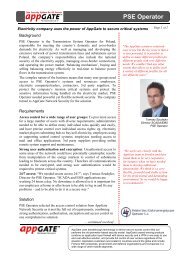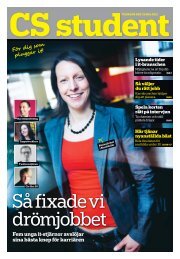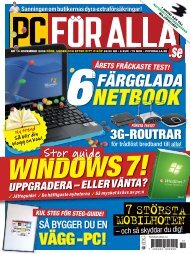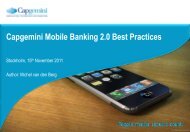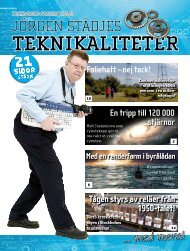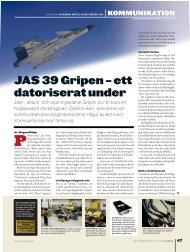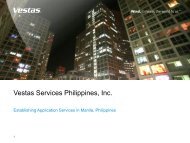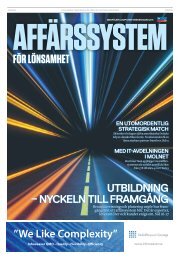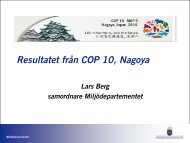CARREFOUR v1.4 - IDG
CARREFOUR v1.4 - IDG
CARREFOUR v1.4 - IDG
Create successful ePaper yourself
Turn your PDF publications into a flip-book with our unique Google optimized e-Paper software.
HP customer case study: World retail leader, Carrefour, substantially improves its businesssupport services by rehosting mainframe applications to HP Integrity serversIndustry: RetailCarrefour rehosting projectBetween July 2006 and November 2007, Carrefour Italia carried outa data centre transformation. Abandoning the mainframe technologyon which most of its core applications depended, the Group undertooka rehosting project to migrate all of the information systems to an openplatform. HP was chosen as the project partner. The new data centre,based on two HP Integrity rx8620 servers, with a dedicated StorageArea Network (SAN) linked to an HP StorageWorks Enterprise VirtualArray (EVA) 8000, was fully functional within 14 months. According tocompany management, migration of the applications and most of therelated environments was a success and the technologically innovativesolution strengthened corporate governance, substantially improvingthe quality of the business support services provided.Objective:• To overcome the integration difficulties connected to mainframe-basedmanagement.• To maximise use of new standardised and open technologies.• To increase the flexibility of corporate governance.• To complete the rehosting project within 18 months.Approach:• HP was chosen as the technological partner for the migration project.• The rehosting project was divided into two phases: the first concerned theadministrative and accounting aspects; the second focused onreferencing, pricing and the supply chain.• Specification of the new platform, using two HP Integrity rx8620 servers,a dedicated Storage Area Network (SAN), linked to an HPStorageWorks Enterprise Virtual Array (EVA) 8000.• For the testing phase, Carrefour invited Unisys and Accenture to the team,who had previously developed the applications that were running on themainframe.Business benefits:• Migration of all applications was completed in only 14 months.• All applications performed as they had on the mainframe.• Faster accounting procedures, thanks to significantly superior responsetimes.• Optimised resources, through capitalisation of corporate expertisewith UNIX.• Improved corporate governance.Operating in 30 countries, with 490,000 employeesand more than 15,000 retail outlets, the CarrefourGroup is the world’s second-largest retailer and thelargest in Europe. With a turnover in 2007 of a7.2billion, Carrefour Italia is the second largest retailer inItaly, with more than 26,000 employees and acommercial network consisting of 1,590 retail outlets.In Italy, the Carrefour Group includes the Carrefourhypermarkets, Supermercati GS, the neighbourhoodsupermarkets DìperDì, Cash & Carry Docks Marketand Gross Iper. The company is continuouslyexpanding throughout Italy, defining sales policiesfocused on its strategy of total service.
Customersolution ata glanceHP hardware• HP Integrity rx8620 servers• HP StorageWorks EnterpriseVirtual Array (EVA) 8000HP services• HP Mainframe Migration Centreof Excellence (MMCOE)Overhaul of the business support infrastructureIn 2005, the support infrastructure for the majority ofthe core business applications depended on a systembased on a Unisys mainframe. Management haddecided to analyse the situation with a view todefining an infrastructure overhaul project. The oldmainframe restricted Carrefour to a single supplier andalso limited the communication with other newerapplication technology platforms. Managementdecided to harmonise the technologies and torationalise the data centre in order to optimisecorporate governance, opening up opportunities forfuture development.“We decided to migrate to open environmentsbecause our mainframe was proprietary: although itwas a high performance machine and completelyappropriate to our needs, it was not in very commonuse. Continuous company growth resulted in theproliferation of various satellite systems – and the moreof these systems there were, the more integrationproblems we faced.”Debora Guma, technology manager, InformationSystems Division, Carrefour Group ItaliaAs a result of years of acquisitions and expansion, thedata-processing landscape was fragmented,consisting of various computer systems in variousbusiness divisions, and was characterised by anheterogeneous application map. The mainframehosted the company’s key applications: asset/liabilitycycle; management of sales items and data registries;as well as part of supply-chain activities. Thecompany’s dynamic growth, as well as volumeincreases in terms of both sales outlets and newapplications, had given rise to solutions developed inMicrosoft and UNIX environments around the Unisysmainframe, which was the heart of Carrefour’sinformation system. As far as the essential corebusiness applications were concerned, the UNIXsystems predominated.“We are a retail operator and our processes aretherefore sophisticated and complex, in terms ofboth type and number. Some of the applicationshad already been written in language that exploitedmore moderate technologies and were thereforeeasier to manage, while others dated back as far asthe early 1980s and, even if they respondedperfectly well to our business needs, they wereoutdated from the point of view of corporategovernance and therefore created considerablemanagement difficulties.”Gabriella Bossi, applications development manager,Information Systems Division, Carrefour Group ItaliaThere were two alternatives, to re-engineer or to rehost.Given the quantity of applications, re-engineering ofthe procedures would have required a great deal oftime. In addition, it would have necessitated a generaloverhaul of processes, which was not a companypriority at the time. The rehosting project was thereforethe most appropriate solution, although it did meanthat the IT division was then faced with a majorundertaking that involved all of the most strategicoperative systems.
The HP rehosting project: the winning modelSince Carrefour Italia is part of a multi-national, itsmanagement turned to the Group. Recognising thequality and professionalism of the Italian IT division,the Group decided that the model proposed was thewinning choice. The supplier selection process lastedsix months. Carrefour asked only for strategicguidelines: to carry out a rehosting project that wouldnot last more than 18 months based on leading – notcustomised – market technologies. When all of thenecessary competencies and technical resources wereput on the table, HP was found to be the best fromboth a technological and an economic point of view.Excellent technological collaborationHP, using the most up-to-date project logistics, tookresponsibility for technological definition of themigration – from set-up of the environments to thesoftware quality cycle – offering complete supportduring the migration process. As requested bymanagement, the rehosting project was divided intotwo phases, a first phase dedicated to theadministrative/accounting aspect and a second phasedevoted to referencing, pricing and supply chain. Theproject was launched in July 2006 and was completed14 months later, in November 2007. The supportarchitecture is built on two HP Integrity rx8620 servers,located in the datacentre at company headquarters inMilan. A dedicated Storage Area Network (SAN)linked to an HP StorageWorks Enterprise Virtual Array(EVA) 8000, was added to the two servers.The scale of the taskIn order to understand the volume of work and theextreme criticality of the project, it is useful to look atsome of the numbers in the most strategic businessareas: billing, data registries, pricing and FSC. Fromthe application point of view, the rehosting providedfor the migration of 13 main systems, involving 35different business models and the porting of anotherseries of company applications: ASTRA (10 businessmodules), AtraNet, Price Lists, Approved Printouts,GPV (four business modules), RILEVA (three businessmodules), GLC, Display (two business modules),Dispatcher, INFOS, Hyper Competition Prices, VEFA(five business modules) and FAAT (four businessmodules). The total number of objects migratedreached 32,418, including 3697 main programmes,23,661 common modules, 4504 JCLs, 108 screensand 448 displays. With respect to databases, themigration involved 1232 relational tables while, at thecode level, 2,960,975 strings were ferried for the mainprogrammes alone, while 1,320,572 modules weretransferred.“During the entire process, HP proved to be a partnerthat excels. On the one hand, we were able to count onconstant assistance from the extremely skilled andprofessional Italian team and, on the other hand, onsupport from the HP Mainframe Migration Centre ofExcellence (MMCOE) Spanish team for migration of themainframe code. The Italian team should be applaudedfor having managed the project outstandingly well.”Debora Guma, technology manager, InformationSystems Division, Carrefour Group ItaliaThanks to the MMCOE‘s know-how and best practices,HP Italia was able to offer value-added vertical
support, which included training in order to speed uplearning of the new methods and approaches.Detailed risk managementThe migration to the new system involved many criticalissues. There was constant pressure on the IT Division,above and beyond the difficulty of moving all of thecompany‘s legacy systems to the new platform. Thevarious teams, working non-stop to bring the project toa successful conclusion, met twice daily to synchronisetheir efforts. The IT Division also made huge efforts interms of communication. Given the application typesinvolved in the migration and the need to shut downduring certain periods, management had to makeevery single phase of the plan transparent, indicatingwhen there would be interruptions. In order toguarantee business continuity, the project alsoincluded the contingency plan of returning to themainframe within two days if problems arose, but thetransition was successfully carried out in both the firstand second phases. The transition was completed in asingle weekend, and everything fell into place exactlyas planned. The rehosting directly involved some 50 ITpersonnel, assisted by around 10 HP professionals.Technological and operative advantagesDuring the first migration phase, management wasalready aware of how successful the project wasturning out to be. As far as the administrative/accounting aspect was concerned, internal userswere able to keep working with the same interfaces.This made the transition absolutely invisible apartfrom the fact that, with the change of technologies,many processes became much faster, which wasobviously greatly appreciated. In the second phase,users previously accustomed to manual tasksnecessary with green-character screens had tofamiliarise themselves with the modified interactiveprocedures. However, according to companymanagers, the new skills had been fully assimilatedwithin a week.Thanks to fine-tuning after the launch, the applicationsmoved to the new open architecture had the sameperformance as on the mainframe, with the samestability and rationalised use of resources. Therehosting project did not slow down businessprocesses and had no negative impact on thecompany‘s operative quality. In addition, the HPIntegrity rx8620 servers, which have a number ofvirtualised partitions, augmented the data centre’sefficacy and efficiency. Architecture homogenisationhas made it possible for Carrefour to improve serviceinfrastructure management and to acquire standardtechnologies that have now created the space for newdevelopment strategies in business support.“HP‘s organisation in support of the project and of theother two main partners (Unisys and Accenture) whocarried out the tests, was excellent. As was thecontribution of the other 18 suppliers involved inverifying systems external to the mainframe. Thesupport of the other company divisions was alsofundamental, because they believed in theprofessionalism and dedication of the peopleresponsible for our Information Systems and acceptedthe inconvenience of project implementation. Thisranged from activity shutdown during the migrationweekends to the need to be involved in user tests so asto verify the proper functioning of applications on thenew platform. On the weekends, the migration wastested and retested down to the smallest detail. HPpersonnel offered continuous support. We had a directline – so day and night, at any time during the week,the HP specialists were always available. This was anenormous additional value. Thanks to HP, we can nowcount on an open and standardised, flexible andscalable platform.”Paolo Sol, director of Information Systems,Carrefour Group ItaliaTo learn more, visit www.hp.com© 2008 Hewlett-Packard Development Company, L.P. The information contained herein is subject to change without notice. The onlywarranties for HP products and services are set forth in the express warranty statements accompanying such products and services.Nothing herein should be construed as constituting an additional warranty. HP shall not be liable for technical or editorial errors oromissions contained herein.Publication Number: A442-0284EEW Written: April 2008 Translated: June 2008



